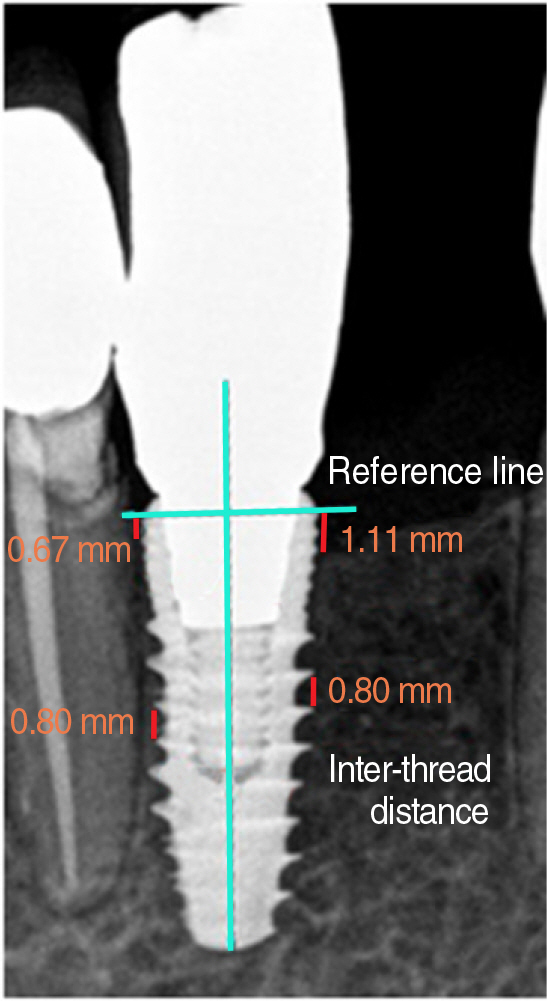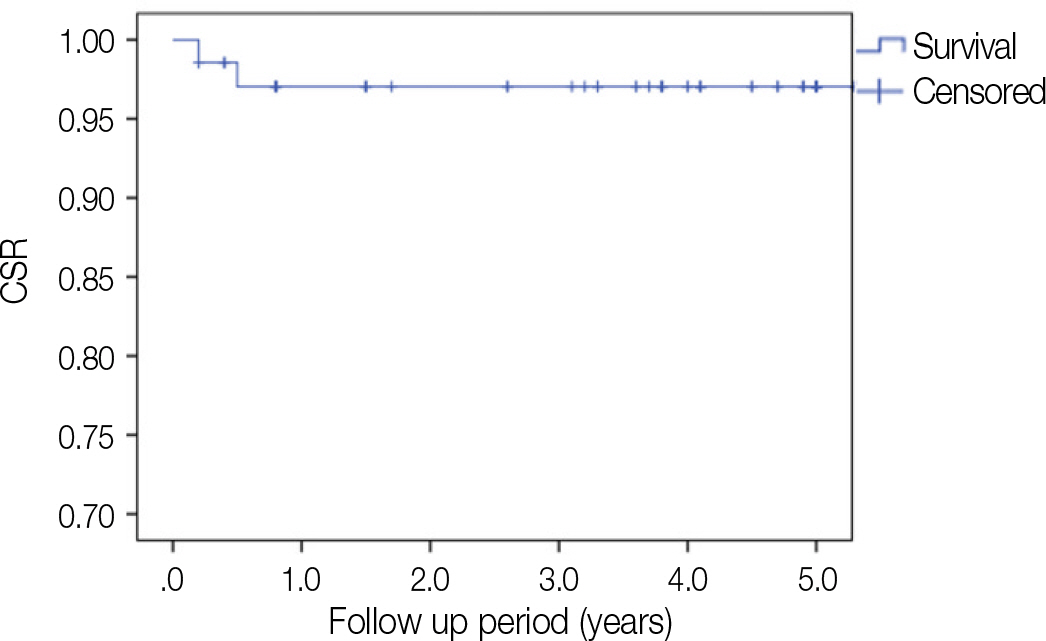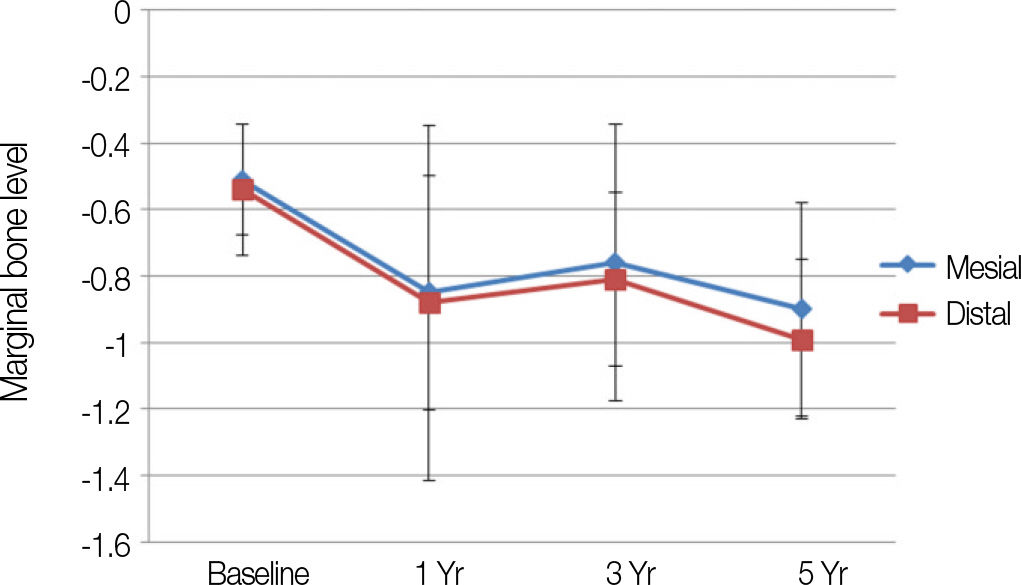J Korean Acad Prosthodont.
2017 Jul;55(3):272-278. 10.4047/jkap.2017.55.3.272.
A 5-year prospective clinical study of Neobiotech implants for partially edentulous patients
- Affiliations
-
- 1Institute for Clinical Dental Research, Korea University Medical Center, Korea University, Seoul, Republic of Korea. wddc@korea.ac.kr
- KMID: 2387199
- DOI: http://doi.org/10.4047/jkap.2017.55.3.272
Abstract
- PURPOSE
The aim of the present prospective clinical study was to assess the cumulative survival rate (CSR) of Neobiotech implants restored with fixed partial prosthesis in relation to its potential risk factors.
MATERIALS AND METHODS
Thirty six partially edentulous patients received Neobiotech implants and implant supported fixed partial prosthesis at Korea University Guro Hospital Dental Center from November 2009 until November 2011. The observation period was set from the implant placement and the last clinical visit until December 2015. Implant survival rate was determined using the Kaplan-Meier method. The relationship between implant survival rate and the potential risk factors were analysed using the multi Cox proportional analysis (P<.05).
RESULTS
A total of 69 implants were placed in 36 patients after a mean observation period of 45.9 months. Two out of 69 implants failed before loading, yielding a 5-year cumulative survival rate of 97.1%. The maxillary implants have a lesser CSR than the mandibular implants based on log rank test analysis (maxilla=91.3%; mandible=100% P<.05). However, the multi Cox proportional analysis showed that implant location has no significant correlation with implant failure (P>.05).
CONCLUSION
Neobiotech implants showed predictable results with a 5 year cumulative survival rate of 97.1%.
Keyword
MeSH Terms
Figure
Cited by 1 articles
-
Early implant failure: a retrospective analysis of contributing factors
Dae-Young Kang, Myeongjin Kim, Sung-Jo Lee, In-Woo Cho, Hyun-Seung Shin, Jordi Caballé-Serrano, Jung-Chul Park
J Periodontal Implant Sci. 2019;49(5):287-298. doi: 10.5051/jpis.2019.49.5.287.
Reference
-
1.Wennerberg A., Albrektsson T. Current challenges in successful rehabilitation with oral implants. J Oral Rehabil. 2011. 38:286–94.
Article2.Lekholm U., van Steenberghe D., Herrmann I., Bolender C., Folmer T., Gunne J., Henry P., Higuchi K., Laney WR., Lindén U. Osseointegrated implants in the treatment of partially edentulous jaws: A prospective 5-year multicenter study. Int J Oral Maxillofac Implants. 1994. 9:627–35.3.Adell R., Lekholm U., Rockler B., Brånemark PI. A 15-year study of osseointegrated implants in the treatment of the edentulous jaw. Int J Oral Surg. 1981. 10:387–416.
Article4.Gaviria L., Salcido JP., Guda T., Ong JL. Current trends in dental implants. J Korean Assoc Oral Maxillofac Surg. 2014. 40:50–60.
Article5.Natiella JR. The use of animal models in research on dental implants. J Dent Educ. 1988. 52:792–7.
Article6.Jemt T., Laney WR., Harris D., Henry PJ., Krogh PH Jr., Polizzi G., Zarb GA., Herrmann I. Osseointegrated implants for single tooth replacement: a 1-year report from a multicenter prospective study. Int J Oral Maxillofac Implants. 1991. 6:29–36.7.Brånemark PI., Hansson BO., Adell R., Breine U., Lindström J., Hallén O., Ohman A. Osseointegrated implants in the treatment of the edentulous jaw. Experience from a 10-year period. Scand J Plast Reconstr Surg Suppl. 1977. 16:1–132.8.Adell R., Eriksson B., Lekholm U., Brånemark PI., Jemt T. Longterm follow-up study of osseointegrated implants in the treatment of totally edentulous jaws. Int J Oral Maxillofac Implants. 1990. 5:347–59.9.Ericsson I., Randow K., Glantz PO., Lindhe J., Nilner K. Clinical and radiographical features of submerged and nonsubmerged titanium implants. Clin Oral Implants Res. 1994. 5:185–9.
Article10.Blanes RJ., Bernard JP., Blanes ZM., Belser UC. A 10-year prospective study of ITI dental implants placed in the posterior region. I: Clinical and radiographic results. Clin Oral Implants Res. 2007. 18:699–706.
Article11.French D., Larjava H., Ofec R. Retrospective cohort study of 4591 Straumann implants in private practice setting, with up to 10-year follow-up. Part 1: multivariate survival analysis. Clin Oral Implants Res. 2015. 26:1345–54.
Article12.Lee JY., Park HJ., Kim JE., Choi YG., Kim YS., Huh JB., Shin SW. A 5-year retrospective clinical study of the Dentium implants. J Adv Prosthodont. 2011. 3:229–35.
Article13.Park W., Park Y., Park H., Yoo S., Chung S., Han J., Kim SW., Kim DM. A 10-year retrospective radiographic study of implan-tium dental implants. Int J Periodontic Restor Dent. 2015. 35:49–54.
Article14.Kim YK., Kim BS., Yun PY., Mun SU., Yi YJ., Kim SG., Jeong KI. The seven-year cumulative survival rate of Osstem implants. J Korean Assoc Oral Maxillofac Surg. 2014. 40:68–75.
Article15.Alsaadi G., Quirynen M., Koma′rek A., van Steenberghe D. Impact of local and systemic factors on the incidence of oral implant failures, up to abutment connection. J Clin Periodontol. 2007. 34:610–7.
Article16.Moy PK., Medina D., Shetty V., Aghaloo TL. Dental implant failure rates and associated risk factors. Int J Oral Maxillofac Implants. 2005. 20:569–77.17.Chrcanovic BR., Kisch J., Albrektsson T., Wennerberg A. Factors influencing early dental implant failures. J Dent Res. 2016. 95:995–1002.
Article18.Barrett-Connor E., Siris ES., Wehren LE., Miller PD., Abbott TA., Berger ML., Santora AC., Sherwood LM. Osteoporosis and fracture risk in women of different ethnic groups. J Bone Miner Res. 2005. 20:185–94.
Article19.Kook YA., Nojima K., Moon HB., McLaughlin RP., Sinclair PM. Comparison of arch forms between Korean and North American white populations. Am J Orthod Dentofacial Orthop. 2004. 126:680–6.
Article20.Shinogaya T., Bakke M., Thomsen CE., Vilmann A., Sodeyama A., Matsumoto M. Effects of ethnicity, gender and age on clenching force and load distribution. Clin Oral Investig. 2001. 5:63–8.
Article21.Yang EJ., Kerver JM., Song WO. Dietary patterns of Korean Americans described by factor analysis. J Am Coll Nutr. 2005. 24:115–21.
Article22.Albrektsson T., Zarb GA. Current interpretations of the os-seointegrated response: clinical significance. Int J Prosthodont. 1993. 6:95–105.23.Sohn DS., Kim WS., Lee WH., Jung HS., Shin IH. A retrospective study of sintered porous-surfaced dental implants in restoring the edentulous posterior mandible: up to 9 years of functioning. Implant Dent. 2010. 19:409–18.
Article24.Chae SW., Kim YS., Lee YM., Kim WK., Lee YK., Kim SH. Complication incidence of two implant systems up to six years: a comparison between internal and external connection implants. J Periodontal Implant Sci. 2015. 45:23–9.
Article25.Cha HS., Kim A., Nowzari H., Chang HS., Ahn KM. Simultaneous sinus lift and implant installation: prospective study of consecutive two hundred seventeen sinus lift and four hundred sixty-two implants. Clin Implant Dent Relat Res. 2014. 16:337–47.
Article26.Eckert SE., Wollan PC. Retrospective review of 1170 endosseous implants placed in partially edentulous jaws. J Prosthet Dent. 1998. 79:415–21.
Article27.Nemli SK., Güngör MB., Aydln C., Yllmaz H., Bal BT., Arlcl YK. Clinical and radiographic evaluation of new dental implant system: Results of a 3-year prospective study. J Dent Sci. 2016. 11:29–34.
Article28.Buser D., Mericske-Stern R., Bernard JP., Behneke A., Behneke N., Hirt HP., Belser UC., Lang NP. Long-term evaluation of nonsubmerged ITI implants. Part 1: 8-year life table analysis of a prospective multi-center study with 2359 implants. Clin Oral Implants Res. 1997. 8:161–72.
Article29.Geckili O., Bilhan H., Geckili E., Cilingir A., Mumcu E., Bural C. Evaluation of possible prognostic factors for the success, survival, and failure of dental implants. Implant Dent. 2014. 23:44–50.
Article30.Lekholm U., Gunne J., Henry P., Higuchi K., Lindén U., Bergström C., van Steenberghe D. Survival of the Brånemark implant in partially edentulous jaws: a 10-year prospective multicenter study. Int J Oral Maxillofac Implants. 1999. 14:639–45.31.Kern JS., Kern T., Wolfart S., Heussen N. A systematic review and meta-analysis of removable and fixed implant-supported prostheses in edentulous jaws: post-loading implant loss. Clin Oral Implants Res. 2016. 27:174–95.
Article32.Friberg B., Jemt T., Lekholm U. Early failures in 4,641 consecutively placed Brånemark dental implants: a study from stage 1 surgery to the connection of completed prostheses. Int J Oral Maxillofac Implants. 1991. 6:142–6.33.Conrad HJ., Jung J., Barczak M., Basu S., Seong WJ. Retrospective cohort study of the predictors of implant failure in the posterior maxilla. Int J Oral Maxillofac Implants. 2011. 26:154–62.34.Esposito M., Hirsch JM., Lekholm U., Thomsen P. Biological factors contributing to failures of osseointegrated oral implants. (II). Etiopathogenesis. Eur J Oral Sci. 1998. 106:721–64.
Article
- Full Text Links
- Actions
-
Cited
- CITED
-
- Close
- Share
- Similar articles
-
- Results of immediate loading for implant restoration in partially edentulous patients: a 6-month preliminary prospective study using SinusQuick(TM) EB implant system
- LONGITUDINAL CLINICAL STUDY ON THE EFFICACY OF OSSEOINTEGRATED DENTAL IMPLANTS IN PARTIALLY EDENTULOUS KOREAN PATIENTS
- Implant-assisted removable partial denture restoration in a partially edentulous patient with a single remaining tooth: a case report
- Fixed/removable reconstruction in partially edentulous patient usin brsitemark osseointegrated implants and two-part I.T.I. implants(bonefit) as abutments
- An assessment of accuracy of half-guided implant surgery using implant surgical guide: A case report




